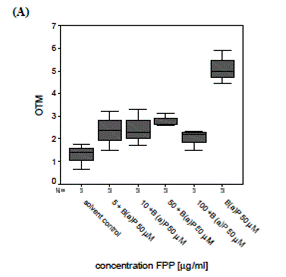Research
Molecular effects of fermented papaya preparation on oxidative damage, MAP Kinase activation and modulation of the benzo[a]pyrene mediated genotoxicity
FILE2006
Category NervesBasic research
Okezie I Aruoma, Renato Colognato, Ilaria Fontana, Joanne Gartlon, Lucia Migliore, Keiko Koike, Sandra Coecke, Evelyn Lamy, Volker Mersch-Sundermann, Inncoronata Laurenza, Luca Benzi, Fumihiko Yoshino, Kyo Kobayashi, Masaichi-Chang-il Lee
The involvement of oxidative and nitrosative stress mechanisms in several biological and pathological processes including aging, cancer, cardiovascular and neurodegenerative diseases has continued to fuel suggestions that processes can potentially be modulated by treatment with free-radical scavengers and antioxidant. The fermented papaya preparation (FPP) derived from Carica papaya Linn was investigated for its ability to modulate oxidative DNA damage due to H2O2in rat pheochromocytoma (PC12) cells.
Cells pre-treated with FPP (50μg/ml) prior to incubation with H2O2 had significantly increased viability and sustenance of morphology and shape. The human hepatoma (HepG2) cells exposed to H2O2 2O2 by about 1.5-fold compared to only H2O2 exposed cells.
Similarly, concentrations ? 50 μg/ml FPP significantly reduced DNA migration in co-treated cells compared with only the benzo[a]pyrene treated cells with a dose of 100 μg/ml FPP reduced the DNA damage 2-fold.
The potential of FPP to regulate the phosphorylation status of ERK 1/2, Akt, and p38 was analyzed by Western blot analysis.
FPP showed the potential to modulate the H2O2 -induced ERK, Akt and p38 activation with the reduction of p38 phosphorylation induced by 250μM H2O2 being more pronounced.
These studies indicate that FPP can modulate oxidative injury supporting the view that prophylactic potentials in neurodegenerative diseases could be facilitated by FPP.

BioFactors 26 (2006)147-159
List of the related papers
Year
Name of Papers
2011
2006
